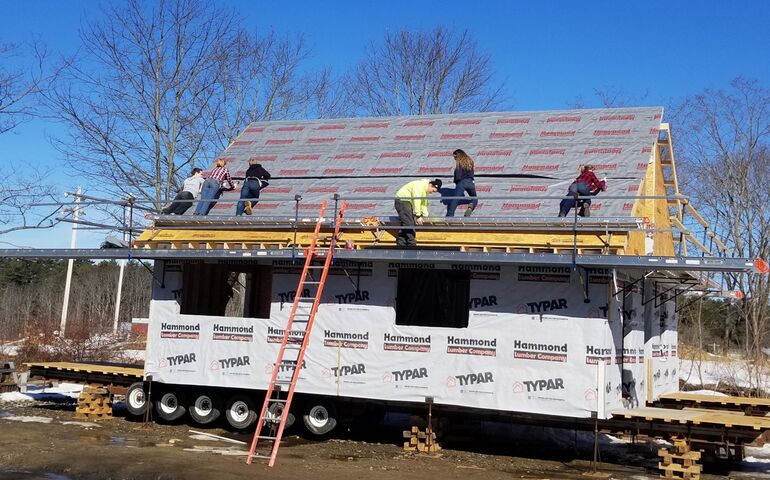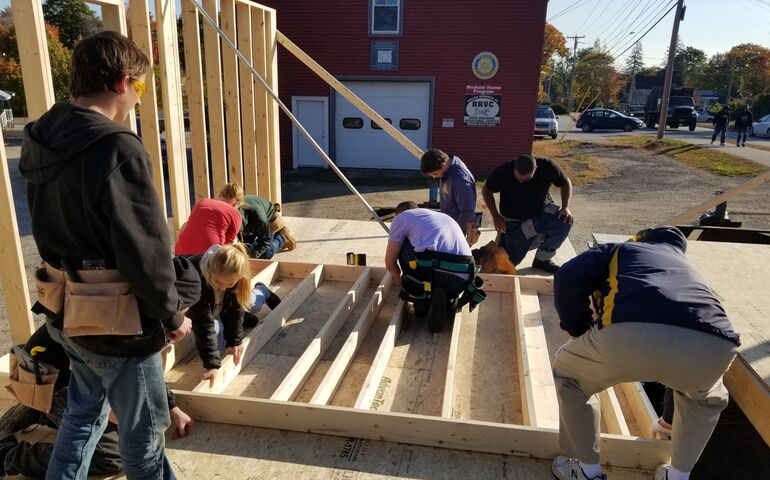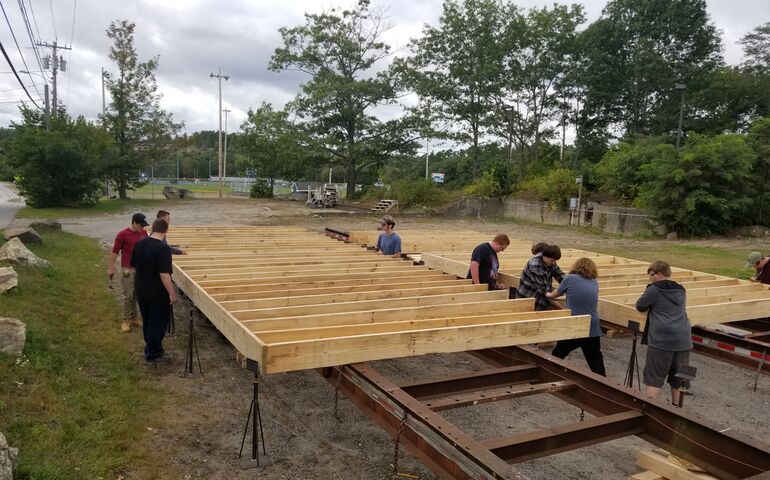
Building a future: More students are enrolling in construction and trades programs
As a crew lowers a house onto a foundation, three young women watch from nearby.
The three students, featured in a video made by the Bath Housing Economic Development Corp. about the house move, aren’t just watching an interesting neighborhood scene — they helped build the house that’s being lowered into place at 57 Chestnut St. in Bath.
“It’s pretty intense to see it actually happen,” says Amber Mixon, one of the teens.
Mixon is one of 31 carpentry students in the Bath Regional Career and Technical Center carpentry program who have worked on the house over the past two years — 21 this year and 10 who graduated last year.
The 720-square-foot house was built offsite, then brought to its lot on Chestnut Street in March.
Students framed, laid out and did all the work to construct the two-bedroom house — including framing, roofing, siding, windows and doors, sheetrock, cabinetry and other tasks.
At the conclusion of the two-year carpentry program, students leave with the skills to enter the field of residential construction or continue at a community college.
The Bath CTC recently revived its electrical program, so students studying that trade will work on future houses, says Julie Kenny, director of the Bath CTC.
Much of the cost of the program is paid for by the Bath Rotary Charitable Trust, a longtime supporter. Vaillancourt Builders LLC, of Bath, offers support, though the work is done by the students. The house was sold to Bath Housing, which will sell it to a family that needs affordable housing.
Leon Vaillancourt, of Vaillancourt Builders, is a longtime supporter of the program.
“As a former student in the BRCTC carpentry program while I was attending Morse High School, I know first-hand the incredible value of learning this trade,” he says. “I’ve been a carpenter/contractor for over 40 years, having gotten my start there. It brings me great joy to serve on this program’s advisory board and work side-by-side with these students.”
Old program, new interest
The house project is nothing new for the program. “We have been building homes since the beginning of the program, which have been sold in different capacities,” says Kenny.
This year’s house is the ninth modular home students in the program have built. Since 1973, the program has built 25 houses.
Kenny says there was a large increase in enrollment in the 2019-20 school year. “I believe we’ll continue to see this pattern, given all of the media we see about the importance of trades for our economy and workforce.”
Students who graduate from the carpentry program are certified to enter the job market, or are ready to enroll in college.
“I think a lot of people don’t realize that students that attend a Career and Technical Education program are also preparing for college, and have that option after graduation if they choose,” Kenny said.

Bringing ‘real value’
The CTC programs are aligned with Maine Community College System programs, and offer students the opportunity to earn college credits even before they enroll in college.
Kenny says while going right from the program into the workplace is an option, “it certainly isn’t the only option.”
“Many of our students do get hired directly from our programs, but others continue on to a two or four-year college and are very successful in that direction,” she says.
Mixon, who was interviewed in the Bath Housing video, will be attending Central Maine Community College in Auburn. She plans to major in HVAC (heating, ventilation, air conditioning and cooling) and minor in business.
The Bath CTC is one of 27 regional centers and programs in the state for high school students. The programs are taught by professionals, and augment the students’ traditional high school education.
The focus is on the learning and developmental needs of students to provide the foundation for educational decision making; use an integrated system of academic and applied learning; and priority is placed on literacy at levels that will serve students throughout their lives “as productive citizens and lifelong learners.”
Hands-on learning
The programs are also “an excellent opportunity for students to learn firsthand through live work experience,” Kenny says.
“Students learn the step-by-step process of building this house, through various units in the classroom and the hand-on build at the jobsite. Watching them learn the math that goes with many of these concepts, and then applying it in the field makes the learning so valuable for these teenagers,” she says. “And there is nothing like visiting the jobsite and seeing the pride on their faces as they explain to me what they have learned and what they are up to.”
Debora Keller, of Bath Housing, says it gave her chills to listen to the students interviewed in the video talk about how much they enjoy the work and what building the house meant to them.
“They’re able to find something to pursue, and that’s absolutely really important for young people,” she says.
Particularly in Bath, home of Bath Iron Works, the trades are a foundation of the workforce, Keller says.
Recent skilled labor shortages have had a profound ripple effect on things like availability of affordable housing.
“There are so many amazing opportunities for young people in the trades,” Keller says.
There’s a value and sense of satisfaction in building something “you can put your hands on,” Keller adds. “This house is an example of that.”














0 Comments